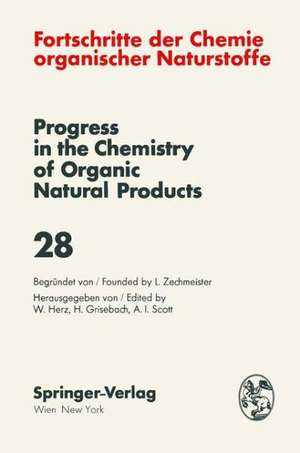Fortschritte der Chemie Organischer Naturstoffe / Progress in the Chemistry of Organic Natural Products: Fortschritte der Chemie organischer Naturstoffe Progress in the Chemistry of Organic Natural Products, cartea 28
Contribuţii de W. Bromer, H. Egge, K. Eiter, R. Eyjolfsson, D. Gross, H. Hikino, Y. Hikino, B.G. Jackson, R.B. Morin, J.E. Pike, E.W. Warnhoff, H. Wiegandt, E. Wongen Limba Engleză Paperback – 8 dec 2011
Din seria Fortschritte der Chemie organischer Naturstoffe Progress in the Chemistry of Organic Natural Products
-
 Preț: 426.18 lei
Preț: 426.18 lei - 15%
 Preț: 651.34 lei
Preț: 651.34 lei -
 Preț: 400.85 lei
Preț: 400.85 lei -
 Preț: 397.01 lei
Preț: 397.01 lei -
 Preț: 403.53 lei
Preț: 403.53 lei -
 Preț: 439.64 lei
Preț: 439.64 lei -
 Preț: 426.94 lei
Preț: 426.94 lei -
 Preț: 419.06 lei
Preț: 419.06 lei -
 Preț: 384.86 lei
Preț: 384.86 lei -
 Preț: 400.26 lei
Preț: 400.26 lei -
 Preț: 406.25 lei
Preț: 406.25 lei -
 Preț: 396.02 lei
Preț: 396.02 lei -
 Preț: 425.20 lei
Preț: 425.20 lei -
 Preț: 401.61 lei
Preț: 401.61 lei -
 Preț: 424.99 lei
Preț: 424.99 lei - 15%
 Preț: 474.50 lei
Preț: 474.50 lei -
 Preț: 395.25 lei
Preț: 395.25 lei -
 Preț: 399.29 lei
Preț: 399.29 lei -
 Preț: 391.22 lei
Preț: 391.22 lei -
 Preț: 431.35 lei
Preț: 431.35 lei - 18%
 Preț: 963.60 lei
Preț: 963.60 lei -
 Preț: 419.43 lei
Preț: 419.43 lei -
 Preț: 441.57 lei
Preț: 441.57 lei -
 Preț: 412.02 lei
Preț: 412.02 lei -
 Preț: 404.29 lei
Preț: 404.29 lei - 18%
 Preț: 1237.30 lei
Preț: 1237.30 lei -
 Preț: 407.39 lei
Preț: 407.39 lei - 15%
 Preț: 655.27 lei
Preț: 655.27 lei - 15%
 Preț: 653.79 lei
Preț: 653.79 lei -
 Preț: 392.97 lei
Preț: 392.97 lei -
 Preț: 395.25 lei
Preț: 395.25 lei -
 Preț: 390.25 lei
Preț: 390.25 lei -
 Preț: 432.12 lei
Preț: 432.12 lei -
 Preț: 388.90 lei
Preț: 388.90 lei -
 Preț: 393.35 lei
Preț: 393.35 lei - 15%
 Preț: 641.53 lei
Preț: 641.53 lei -
 Preț: 392.75 lei
Preț: 392.75 lei -
 Preț: 389.70 lei
Preț: 389.70 lei -
 Preț: 387.58 lei
Preț: 387.58 lei -
 Preț: 385.84 lei
Preț: 385.84 lei -
 Preț: 387.75 lei
Preț: 387.75 lei -
 Preț: 387.58 lei
Preț: 387.58 lei -
 Preț: 393.74 lei
Preț: 393.74 lei -
 Preț: 395.63 lei
Preț: 395.63 lei -
 Preț: 386.22 lei
Preț: 386.22 lei
Preț: 400.85 lei
Nou
Puncte Express: 601
Preț estimativ în valută:
76.70€ • 80.09$ • 63.34£
76.70€ • 80.09$ • 63.34£
Carte tipărită la comandă
Livrare economică 15-29 aprilie
Preluare comenzi: 021 569.72.76
Specificații
ISBN-13: 9783709171257
ISBN-10: 3709171253
Pagini: 516
Ilustrații: XII, 503 p.
Dimensiuni: 155 x 235 x 27 mm
Greutate: 0.72 kg
Ediția:Softcover reprint of the original 1st ed. 1970
Editura: SPRINGER VIENNA
Colecția Springer
Seria Fortschritte der Chemie organischer Naturstoffe Progress in the Chemistry of Organic Natural Products
Locul publicării:Vienna, Austria
ISBN-10: 3709171253
Pagini: 516
Ilustrații: XII, 503 p.
Dimensiuni: 155 x 235 x 27 mm
Greutate: 0.72 kg
Ediția:Softcover reprint of the original 1st ed. 1970
Editura: SPRINGER VIENNA
Colecția Springer
Seria Fortschritte der Chemie organischer Naturstoffe Progress in the Chemistry of Organic Natural Products
Locul publicării:Vienna, Austria
Public țintă
ResearchCuprins
Structural and Biogenetic Relationships of Isoflavonoids.- I. Introduction.- II. Isoflavones.- III. Isoflavanones.- IV. Rotenoids.- V. Pterocarpans.- VI. Isoflavans.- VII. 3-Aryl-4-hydroxycoumarins.- VIII. Coumestans.- IX. Other Types of Isoflavonoids.- X. Biogenesis of Isoflavonoids.- References.- Recent Advances in the Chemistry of Cyanogenic Glycosides.- I. Introduction.- II. General Chemical Considerations.- III. Detection.- IV. Isolation.- V. Structure Elucidation.- VI. Synthesis.- VII. Distribution.- VIII. Biosynthesis.- IX. Metabolic Aspects.- References.- Naturstoffe mit Pyridinstruktur und ihre Biosynthese.- Einführung.- Peptide Alkaloids.- I. Introduction.- II. General Properties of Peptide Alkaloids.- III. General Methods and Techniques of Structural Determination.- IV. Structure and Properties of Peptide Alkaloids.- V. Ultraviolet Spectra of Peptide Alkaloids.- VI. NMR Spectra of Peptide Alkaloids.- VII. Mass Spectra of Aryloxy Macrocyclic Peptide Alkaloids.- VIII. Pharmacological Properties of Peptide Alkaloids.- IX. Tables.- References.- Insektensexuallockstoffe.- I. Einleitung.- II. Insektensexuallockstoffe.- III. Weitere Pheromone.- IV. Insektenhormone.- Arthropod Molting Hormones.- I. Introduction.- II. Hormonal Regulation of Growth of Insects and Crustaceans.- III. Occurrence in Animals.- IV. Occurrence in Plants.- V. Isolation and Assay.- VI. Structure Determination and Chemistry.- VII. Synthesis.- VIII. Biosynthesis and Catabolism.- IX. Tables.- References.- Total Synthesis of Prostaglandins.- I. Introduction.- II. Structure and Chemical Transformations of the Prostaglandins.- III. General Approaches to Prostaglandin Synthesis.- IV. Synthetic Routes to Structurally Simplified Prostaglandins.- V. Synthetic Routes to Prostaglandin Analogs.- VI.Miscellaneous Synthetic Approaches.- VII. Resolution of Racemic Prostaglandins.- References.- Chemistry of Cephalosporin Antibiotics.- I. Introduction.- II. Isolation and Structure of Cephalosporin Antibiotics.- III. Chemical Transformations of Cephalosporin C.- IV. Physicochemical Properties of Cephalosporanates.- V. Syntheses of Cephalosporins.- VI. Biosynthesis.- VII. Biological Activity of Cephalosporanates.- References.- Oligosaccharide der Frauenmilch.- I. Einleitung.- II. Isolierung und Analyse der Oligosaccharide.- III. Beschreibung der Zucker.- IV. Vergleich der freien Kohlenhydrate der Milch und des Urins mit den konjugierten Oligosacchariden der Glykosphingolipide.- V. Biosynthese und Blutgruppenmerkmale.- Glucagon: Chemistry and Action.- I. Introduction.- II. Assay.- III. Chemical Aspects.- IV. Site of Formation and Release.- V. Glucagon in Blood.- VI. Glucagon Action.- VII. Physiologic Role.- References.- Namenverzeichnis. Author Index.- Sachverzeichnis. Subject Index.










